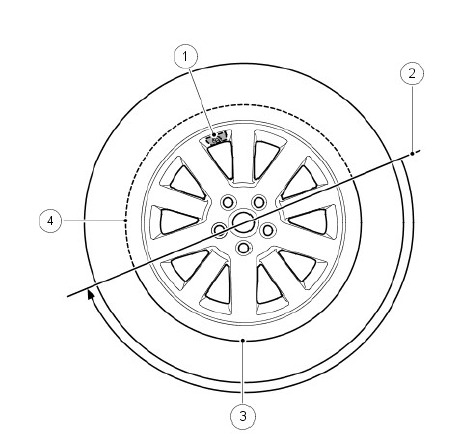Land Rover Discovery: Wheels and Tires - Overview
Overview
COMPONENT LOCATION
NOTE:
Only vehicles fitted with a full-size spare wheel are equipped with a tire pressure sensor in the spare wheel.
TIRE PRESSURE MONITORING SYSTEM (TPMS)
.jpg)
- Instrument Cluster (IC)
- Tire Pressure Monitor (TPM) module
- Tire Pressure Sensor - 4 off
OVERVIEW
Tire Pressure Monitoring System (TPMS)
The purpose of the Tire Pressure Monitoring System (TPMS) is to assist the driver in maintaining the vehicle's tire pressures at the optimum level in order to:
- improve fuel consumption
- maintain ride and handling characteristics
- reduce the risk of rapid tire deflation - which may be caused by under inflated tires
- comply with legislation in relevant markets.
The TPMS measures the pressure in each of the tires on the vehicle and issues warnings to the driver if any of the pressures deviate from defined tolerances.
NOTES:
- During a tire 'blow-out' a very rapid reduction in pressure is experienced. The system is not intended to warn the driver of a 'blow-out', as it is not possible to give the driver sufficient warning that such an event is occurring, due to its short duration. The design of the TPMS is to assist the driver in keeping the tires at the correct pressure, which will tend to reduce the likelihood of a tire 'blow-out' occurring.
- TPMS is inhibited when the vehicle is in Delivery mode. For more details on Delivery mode refer to the PDI manual.
A single TPMS hardware configuration is used. TPMS status information is relayed to the driver with a message displayed in the Instrument Cluster (IC) message center and an amber warning indicator.
TIRES
CAUTION:
Care must be taken when removing and refitting tires to ensure that the tire pressure sensor is not damaged.
NOTES:
- The TPMS valve should be serviced using the suitable service kit,
each time the tire is dismounted, to ensure an air tight seal.
Attention should be made to the detail of fitting this kit.
- If the metal valve stem is damaged, it can be replaced independently of the tire pressure sensor. A damaged valve stem does not necessitate the replacement of the entire sensor.

- Tire valve and pressure sensor
- Tire fitting/removal tool initial start position
- High tire and bead tension area
- Low tire and bead tension area
When removing the tire, the bead breaker must not be used within 90 degrees of the tire valve in each direction.
When using the tire removal machine, the fitting arm start position must be positioned as shown in the tire changing illustration. The wheel can then be rotated through 180 degrees in a counterclockwise direction. This will relieve the high tension from the tire bead allowing the remaining 180 degrees of the tire to be manually pulled from the rim.
When refitting the tire, position the fitting arm as shown. Rotate the tire and take care that the bead on the low tension side of the tire does not damage the sensor.
TREAD ACT - NAS ONLY
Vehicles supplied to the North American markets must comply with the legislation of the Transport Recall Enhancement, Accountability and Documentation (TREAD) act. Part of the requirement of the TREAD act is for the vehicle to display a label, positioned on the driver's side B-pillar, which defines the recommended tire inflation pressure, load limits and maximum load of passengers and luggage weight the vehicle can safely carry. This label will be specific to each individual vehicle and will be installed on the production line.
This label must not be removed from the vehicle. The label information will only define the specification of the vehicle as it came off the production line.
It will not include dealer or owner fitted accessory wheels and tires of differing size from the original fitment.
NOTES:
- If tires and wheels of a non-standard size are fitted to the vehicle, the car configuration file must be updated using a Land Rover approved diagnostic system.
- If the label is damaged or removed for body repair, it must be replaced with a new label specific to that vehicle. A new label is requested from Land Rover parts and will be printed specifically for the supplied VIN of the vehicle.

